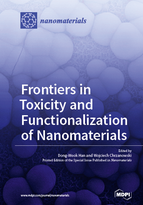Frontiers in Toxicity and Functionalization of Nanomaterials
A special issue of Nanomaterials (ISSN 2079-4991).
Deadline for manuscript submissions: closed (30 September 2017) | Viewed by 78681
Special Issue Editors
Interests: nanobiomaterials; tissue engineering; regenerative medicine; 3D bioprinting; cells/tissues/organs-on-chips; medical devices
Special Issues, Collections and Topics in MDPI journals
Interests: nanomedicine; biointefaces; nanomaterials; nanocharacterisation
Special Issue Information
Dear Colleagues,
Over the last decade, various nanomaterials (NMs) have attracted tremendous attention with the incredible development in nanoscience and nanotechnology. Some NMs are explored increasingly for biomedical applications including drug delivery carriers, imaging probes, antimicrobial agents, biosensors and tissue engineering scaffolds. However, the in vitro and in vivo toxicities of NMs related to oxidative stress are the main obstacles to use them in biomedical fields. One of the most promising strategies to address these obstacles is functionalizing NMs with biocompatible molecules or materials.
In this Special Issue, we are especially interested in manuscripts that advance the understanding of the interaction of NMs with cells, tissues, organs and systems as well as the relationship between intrinsic property and biocompatibility of NMs. This Special Issue invites manuscripts ranging from understanding all toxicological aspects, such as cytotoxicity, genotoxicity, hemotoxicity, neurotoxicity, immunotoxicity, histotoxicity and systemic toxicity of NMs. Manuscripts that focus on specific approaches and strategies to modify NMs with biofunctional moieties are also invited.
Prof. Dr. Dong-Wook Han
Dr. Wojciech Chrzanowski
Guest Editors
Manuscript Submission Information
Manuscripts should be submitted online at www.mdpi.com by registering and logging in to this website. Once you are registered, click here to go to the submission form. Manuscripts can be submitted until the deadline. All submissions that pass pre-check are peer-reviewed. Accepted papers will be published continuously in the journal (as soon as accepted) and will be listed together on the special issue website. Research articles, review articles as well as short communications are invited. For planned papers, a title and short abstract (about 100 words) can be sent to the Editorial Office for announcement on this website.
Submitted manuscripts should not have been published previously, nor be under consideration for publication elsewhere (except conference proceedings papers). All manuscripts are thoroughly refereed through a single-blind peer-review process. A guide for authors and other relevant information for submission of manuscripts is available on the Instructions for Authors page. Nanomaterials is an international peer-reviewed open access semimonthly journal published by MDPI.
Please visit the Instructions for Authors page before submitting a manuscript. The Article Processing Charge (APC) for publication in this open access journal is 2900 CHF (Swiss Francs). Submitted papers should be well formatted and use good English. Authors may use MDPI's English editing service prior to publication or during author revisions.
Keywords
biomedical applications,
nanotoxicity,
cell-nanomaterial interactions,
biocompatibility,
nanomaterial functionalization








